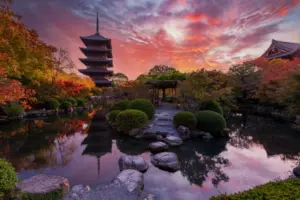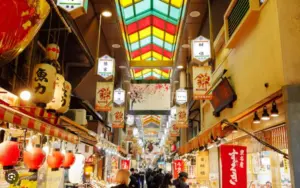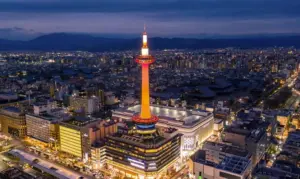Kyoto, Japan, unfolds as a mesmerizing tapestry of tradition and modernity, where ancient temples and historic gardens harmoniously coexist with bustling city life.
This cultural gem, nestled in the heart of the Kansai region, invites travellers to step back in time while immersing themselves in the vibrant pulse of contemporary Japan.
In this article, we embark on a virtual journey to uncover the secrets of Kyoto, exploring its serene landscapes, rich history, and the unique cultural treasures that make it a destination like no other.
Temples and Tranquillity

Temple in Kyoto
Kyoto’s Spiritual Sanctuaries
Kyoto is renowned for its wealth of ancient temples, each standing as a testament to the city’s spiritual heritage. The iconic Fushimi Inari Taisha, with its thousands of vermilion torii gates, leads visitors through a mystical path on Mount Inari. Kinkaku-ji, the Golden Pavilion, captivates with its shimmering exterior set against the reflective waters of Kyoko-chi pond. These sacred spaces not only showcase architectural brilliance but also provide havens for contemplation and tranquillity.
Sakura Splendor in Maruyama Park
During spring, Kyoto transforms into a canvas of pink and white hues as cherry blossoms blanket the city. Maruyama Park, one of Kyoto’s oldest parks, becomes a prime location for hanami (cherry blossom viewing) picnics. Under the blooming sakura trees, locals and visitors alike share moments of serenity and appreciation for the ephemeral beauty of nature, forging connections amidst the delicate petals that symbolize the fleeting nature of life.
Kyoto’s Moss Gardens – Gion District
The Gion district, known for its historic streets and traditional tea houses, unveils hidden gems like the enchanting moss gardens. Places like the Gio-ji Temple boast moss-covered grounds that transport visitors to a world of serene beauty. The quiet simplicity of these gardens provides a stark yet harmonious contrast to the lively energy of Gion’s streets, creating a balance that defines Kyoto’s unique charm.
Kyoto Timeless Traditions and Cultural Treasures

Nishiki Marketplace Kyoto
Kyoto’s Geisha Legacy in Gion
Gion, Kyoto’s historic entertainment district, is synonymous with the world of geisha. Strolling through Hanami-koji, Gion’s main street, one may catch a glimpse of geiko (geisha) and maiko (apprentice geisha) gracefully making their way to tea houses. Gion’s traditional wooden machiya (townhouses) and the atmospheric glow of lantern-lit streets preserve the elegance and mystique of Kyoto’s geisha culture, inviting visitors into a world where time seems to stand still.
Nishiki Market – Culinary Exploration
Nishiki Market, often referred to as “Kyoto’s Kitchen,” is a food lover’s paradise. This bustling market, spanning five blocks, showcases Kyoto’s culinary treasures. From fresh seafood and traditional sweets to matcha-flavored delights, Nishiki Market offers a sensory journey through Kyoto’s gastronomic heritage. It’s a place where the aromas of local delicacies mingle with the vibrant colours of market stalls, creating a feast for both the eyes and the palate.
Kyoto’s Traditional Arts – Tea Ceremonies and Ikebana
Kyoto’s commitment to preserving traditional arts is evident in the practice of tea ceremonies and ikebana (flower arranging). Visitors can partake in tea ceremonies at historic tea houses, where every gesture, from the preparation of matcha to the placement of utensils, is a choreographed art form. Ikebana, the Japanese art of flower arranging, graces Kyoto with its elegance, with schools and workshops inviting participants to delve into the world of harmonious floral compositions.
Modern Kyoto and Urban View

Kyoto City Night View
Kyoto International Manga Museum
While steeped in history, Kyoto embraces modernity with institutions like the Kyoto International Manga Museum. Housing over 300,000 manga from around the world, this museum celebrates the contemporary art of storytelling. Visitors can freely browse and read from the vast manga shelves, blurring the lines between literature and interactive cultural experience.
Kyoto Tower and City Skyline
For panoramic views of the city, Kyoto Tower stands tall, offering an observation deck that provides a sweeping vista of Kyoto’s skyline. As the day transforms into night, the city lights up, and Kyoto’s modern urban allure becomes apparent. The juxtaposition of historical landmarks and contemporary structures showcases the city’s ability to seamlessly merge the past and present.
Arashiyama Bamboo Grove and Togetsukyo Bridge
Arashiyama, on the western outskirts of Kyoto, introduces visitors to a magical bamboo forest. The towering bamboo stalks create an ethereal atmosphere, especially when sunlight filters through the dense canopy. Nearby, the Togetsukyo Bridge spans the Hozu River, offering a picturesque setting that encapsulates Kyoto’s ability to merge natural beauty with architectural grace.
In Conclusion: Kyoto’s Timeless Allure
Kyoto, with its tranquil temples, cultural treasures, and modern urban charm, stands as a city where time seems to weave through the centuries. From the ethereal beauty of cherry blossoms to the enchantment of Gion’s lantern-lit streets, Kyoto invites explorers to uncover the layers of its cultural richness.
List of 10 Kyoto Marvels:
- Fushimi Inari Taisha
- Kinkaku-ji (Golden Pavilion)
- Maruyama Park
- Gion District
- Nishiki Market
- Kyoto International Manga Museum
- Kyoto Tower
- Arashiyama Bamboo Grove
- Tea Ceremonies in Kyoto
- Ikebana (Flower Arranging) in Kyoto
In concluding our virtual journey through this timeless city, one cannot help but be captivated by the allure of Kyoto—where tradition and modernity coalesce in a symphony of beauty and grace.











